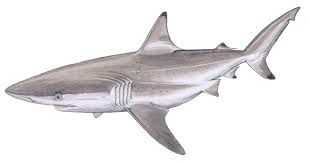Spinner Shark

Species Details
Carcharhinus Brevipinna
Carcharhinidae
Carcharhiniformes
Onshore, Nearshore, Shallows
60 - 120 lbs.
72" - 118"
Spinner Shark
(Carcharhinus Brevipinna)
Fish Description
The Spinner Shark has a long and pointed snout, relatively small dorsal fin, and slender body. The upper part of its body is gray or bronze, while the lower part is white. They are often mistaken for a blacktip shark because both species look similar with having fins with a gray or blacktip. They get their name from its feeding maneuvering. They hunt schools of small fish by swimming through them with their mouths wide open, all while spinning out of the water. They are capable of leaping speeds of 46 mph. This species of requiem shark is from the genus Carcharhinus which are known as ground sharks. Their characteristics include five gill slits, moveable eyelids that protect their eyes from injury, two spineless dorsal fins, an anal fin, and an upper jaw filled with sharp teeth located behind the eyes.
Fish Size
The biggest Spinner Shark recorded is 9.8 and 200 feet, but on average, the adults are 6.6 feet and weigh 123 pounds. Spinners can live up to 20 years old.
Interesting Facts about Spinner Sharks
Commercial fishermen mistakenly target Spinner Sharks in the southeastern United States and throughout the Gulf of Mexico. When caught, the meat is often sold as the Blacktip Shark. Because the two species are very similar, the threatened Spinner is likely to be underreported.
Spinner Sharks are aptly-named for their out-of-the water leaping and rotating up to 3 times in the air before falling back into the water.
Like other members of this shark species, the Spinner Shark is viviparous and will give birth to live young. The average litter size is 3 to 15 pups that will quickly move into shallow water estuaries where there is plenty of food and few predators.
Spinners have poor eyesight and a strong sense of smell. They are smell hunters.
Spinner Shark's teeth are narrow and triangular on the upper and lower jaw. Though Spinner Shark's teeth are very strong to cut through fish, smaller sharks, and squid, they are not considered dangerous to humans.
Fish Diet
Spinner sharks mainly feed on different bony fish like sardines, tenpounders, herring, anchovies, lizard fish, sea catfish, bonito, tunas, and croakers. They will also eat cuttlefish, squid, stingrays, and the occasional octopus. They are usually seen hunting schools of prey at high speed. Groups of Spinner Sharks will charge through the groups of fish, spinning on their axis with open mouths to snap the prey around it. They usually travel in large groups in search of smaller fish prey.
Fishing Method
To catch the Spinner Shark, use live bait, artificial bait, and even cut bait. Drifting, casting, and still fishing is the common technique for spinner sharks. The best tackles range from medium to heavy spinning tackle with light ocean gear. Spinner Sharks have poor eyesight but a strong sense of smell. Live Pilchards and related baitfish are the best choices for fishing. Bonito is the most common bait for spinner sharks as they have high oil and blood content. You can also catch spinner sharks with mullet, ladyfish, bluefish, and king mackerel. For the fly fisherman, the biggest and brightest flies will catch their attention. For an added incentive, soak your flies in power bait recharge.
Spinner Sharks live in tropical and warm temperate waters around the world. In the United States, you will find them in the Gulf of Mexico. During late winter and early spring, they migrate to the beaches of Fort Lauderdale and West Palm Beach chasing fish that are breeding & feeding in and just beyond the surf. They live in a wide ocean area but have preferences for water less than 98 feet deep. They are migratory sharks, which generally stay in warm waters during spring and summer, and move into deeper waters in cold seasons.
Distribution
Spinner Sharks are found in the Atlantic Ocean along the southeast coast of the United States, Gulf of Mexico, and South America. These sharks are considered to be the smaller sharks in the species. The Spinners found in North Africa and around Japan, the Philippines, Vietnam, the Indian Ocean, and throughout South Africa are a larger species.







